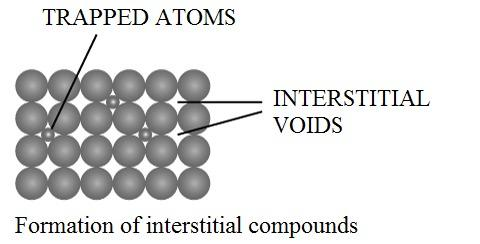
What are interstitial compounds? Why do these compounds have higher melting points than corresponding pure metals?
Answer
124.8k+ views
Hint: The melting point of an element or a compound can be stated as the temperature or the point when a solid changes its state to liquid.
Complete step-by-step solution:
Interstitial compounds are marked by the presence of some atoms like ${\rm{N,C}}$or ${\rm{H}}$. These atoms are trapped inside of the vacant interstitial spaces in the crystal lattice of the metals.${\rm{M}}{{\rm{n}}_{\rm{4}}}{\rm{H,F}}{{\rm{e}}_{\rm{3}}}{\rm{H,}}\,{\rm{Ti}}{{\rm{H}}_{{\rm{1}}{\rm{.73}}}}{\rm{,TiC}}$ are some common examples of interstitial compounds.
These interstitial compounds have higher melting points than corresponding pure metals. It is because these compounds are inert chemically, they are usually hard, and these compounds are stabilized due to the presence of foreign atoms.

The above figure shows the presence of interstitial elements vacant interstitial spaces of the crystal lattice.
Additional information:
Transition metals form a lot of interstitial compounds. Transition metals react with elements like hydrogen, nitrogen, boron, carbon etc. forming interstitial compounds.
The various properties of the interstitial compounds are:
(a)Interstitial compounds are rigid and hard. It is because in the interstitial compound, the vacant spaces of the transition metals are filled up by the small atoms
(b) During the formation of interstitial compounds, the chemical properties of the parent transition metal do not get changed or altered. Various changes in the physical properties take place in the parent metals such as hardness, density, rigidity, ductility, malleability, electrical conductivity etc.
Note: Presence of some atoms like ${\rm{N,C}}$or ${\rm{H}}$ trapped in the vacant spaces in the crystal lattice gives rise to the interstitial compounds. The melting points of these compounds are higher than that of pure metals due to bonding between the metal and the non-metals, which is stronger than the metal-metal bonding.
Complete step-by-step solution:
Interstitial compounds are marked by the presence of some atoms like ${\rm{N,C}}$or ${\rm{H}}$. These atoms are trapped inside of the vacant interstitial spaces in the crystal lattice of the metals.${\rm{M}}{{\rm{n}}_{\rm{4}}}{\rm{H,F}}{{\rm{e}}_{\rm{3}}}{\rm{H,}}\,{\rm{Ti}}{{\rm{H}}_{{\rm{1}}{\rm{.73}}}}{\rm{,TiC}}$ are some common examples of interstitial compounds.
These interstitial compounds have higher melting points than corresponding pure metals. It is because these compounds are inert chemically, they are usually hard, and these compounds are stabilized due to the presence of foreign atoms.

The above figure shows the presence of interstitial elements vacant interstitial spaces of the crystal lattice.
Additional information:
Transition metals form a lot of interstitial compounds. Transition metals react with elements like hydrogen, nitrogen, boron, carbon etc. forming interstitial compounds.
The various properties of the interstitial compounds are:
(a)Interstitial compounds are rigid and hard. It is because in the interstitial compound, the vacant spaces of the transition metals are filled up by the small atoms
(b) During the formation of interstitial compounds, the chemical properties of the parent transition metal do not get changed or altered. Various changes in the physical properties take place in the parent metals such as hardness, density, rigidity, ductility, malleability, electrical conductivity etc.
Note: Presence of some atoms like ${\rm{N,C}}$or ${\rm{H}}$ trapped in the vacant spaces in the crystal lattice gives rise to the interstitial compounds. The melting points of these compounds are higher than that of pure metals due to bonding between the metal and the non-metals, which is stronger than the metal-metal bonding.
Recently Updated Pages
Types of Solutions - Solution in Chemistry

Difference Between Crystalline and Amorphous Solid

JEE Main Participating Colleges 2024 - A Complete List of Top Colleges

JEE Main Maths Paper Pattern 2025 – Marking, Sections & Tips

Sign up for JEE Main 2025 Live Classes - Vedantu

JEE Main 2025 Helpline Numbers - Center Contact, Phone Number, Address

Trending doubts
JEE Main 2025 Session 2: Application Form (Out), Exam Dates (Released), Eligibility & More

JEE Main Exam Marking Scheme: Detailed Breakdown of Marks and Negative Marking

JEE Main 2023 January 24 Shift 2 Question Paper with Answer Keys & Solutions

Learn About Angle Of Deviation In Prism: JEE Main Physics 2025

JEE Main 2025: Conversion of Galvanometer Into Ammeter And Voltmeter in Physics

JEE Main Login 2045: Step-by-Step Instructions and Details

Other Pages
NCERT Solutions for Class 11 Chemistry Chapter 7 Redox Reaction

NCERT Solutions for Class 11 Chemistry Chapter 5 Thermodynamics

JEE Advanced Marks vs Ranks 2025: Understanding Category-wise Qualifying Marks and Previous Year Cut-offs

NCERT Solutions for Class 11 Chemistry Chapter 8 Organic Chemistry

NCERT Solutions for Class 11 Chemistry Chapter 6 Equilibrium

NCERT Solutions for Class 11 Chemistry Chapter 9 Hydrocarbons




